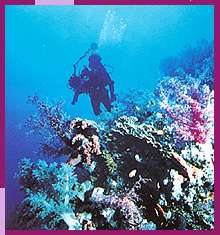Red
Sea Coast
INTRODUCTION
The
Red Sea extends from the Gulf of Suez and Gulf of Aqaba in
the north, to the narrow straits of the Bab al-Mandab - the
Gate of Sorrows - where the Sea joins the Indian Ocean. The
Egyptian Red Sea coastline includes the Gulf of Suez, the
west coast of the Gulf of Aqaba and the northernmost third
or so of the west coast of the Red Sea itself. The Gulf of
Suez is connected to the Mediterranean through the Suez Canal
in northern Egypt, which makes it an important shipping route.
Actually, the Red Sea has been a major trading route since
ancient times: important commodities have included frankincense
(a tree from the Horn of Africa) and coffee (first shipped
to the West from the Red Sea port of Mokha in Yemen - hence
Mocha).
RED
SEA FORMATION AND STRUCTURE
The
Red Sea is an example of a newly forming ocean: the African
and Arabian continents are moving away from each other and
rifting apart to form new crust under the Red Sea, which is
gradually getting wider. All the world's oceans were formed
by continents splitting apart in this way and were once geologically
similar to the Red Sea. The process is visible in the way
that the African and Arabian coastlines of the Red Sea fit
together like a jigsaw puzzle, except in the very south where
the rifting process has lifted a piece of ocean floor up above
sea level to form the basaltic mountains of Eritrea and Ethiopia.
Geologically speaking, the Red Sea is very young. It started
to open about 25 million years ago, some 40 million years
after the extinction of the dinosaurs.
|

|
During
the process of its formation the Red Sea was at various times
connected to the Mediterranean, but only became connected
to the Indian Ocean about 5 million years ago - very recently
in geological time.
Seawater
flooded newly forming sea several times and then dried up
when the movement of the continents cut the connection. This
has left huge deposits of salt buried under the sea bed. Under
pressure, salt domes up and pushes towards the surface, causing
islands where it lifts the seafloor up. Many of the islands
in the Red Sea, including some of those around Hurghada in
Egypt are formed in this way. Marine life in the Sea was killed
each time the Sea was cut off since it would have become a
highly salty brine lake, below sea level - rather like a huge
version of the Dead Sea. The fossil skeletons of decomposing
marine organisms form the oil and gas deposits which are mined
along the Egyptian and Arabian coasts today.
 |
The
rift in the Earth's crust under the Red Sea means that it
is deep (over 2,000 metres in places) and geologically active.
Its deepest areas have numerous volcanic vents, where new
crust is formed from magma brought up from the Earth's mantle.
Seawater percolates through these vents and emerges hot, salty
and rich in metals.
This
salty water is dense, and forms pools of hot brine in the
deepest areas of the sea, with unique forms of bacteria thriving
in the water, which is toxic to nearly all other life forms.
Several of the coastal countries have considered mining this
water for its metals, but suitable technology is not yet available.
(Jo
Gascoigne)
|
|